|
Continued from
FrontPage of Article

PERFORMANCE OF THE SINGAPORE ECONOMY IN SECOND QUARTER 2007 AND
OUTLOOK FOR 2007
Overall Performance
The Singapore economy expanded by 8.6% in 2Q07 following 6.4% in
1Q07. Growth on a seasonally-adjusted quarter-on-quarter annualised
basis increased to 14% in 2Q07 from 8.8% a quarter earlier.
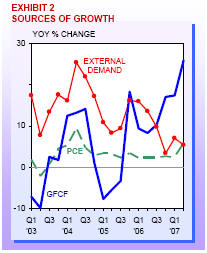
Sources of Growth
Total demand growth moderated to 6.8% from 7.7% in the previous
quarter. Domestic demand grew by 12% due to stronger growth in
private consumption and investments. External demand growth eased to
5.4%, due to slower growth in goods exports.
Sectoral Performance
Growth in the second quarter was led by the financial services and
construction sectors which experienced double-digit growth in 2Q07
(see Annex).
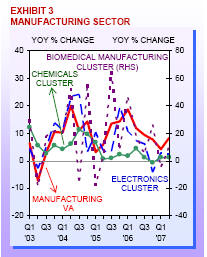
THE MANUFACTURING SECTOR grew by 8.3% in 2Q07, up from 4.4% in the
previous quarter. The transport engineering cluster continued to
expand strongly at 31% following a 23% increase in 1Q07. The
biomedical manufacturing cluster also recovered from a 5.1%
contraction in 1Q07 to register an increase of 11% in 2Q07.
Precision engineering, however, fell by 2.0% while electronics and
chemicals grew by 2.5% and 1.4% respectively during the quarter.
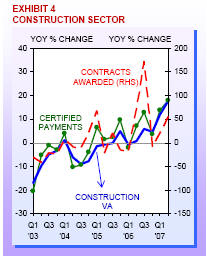
THE CONSTRUCTION SECTOR expanded by 18% in 2Q07, its strongest
growth since 3Q97. Growth momentum was robust, at 15%. Certified
payments increased by 18% in 2Q07, supported by strong growth in the
private residential, commercial and industrial segments as well as
public residential segment. Contracts awarded increased 55% in 2Q07,
due mainly to the rise in the private commercial and public
institutional segments.
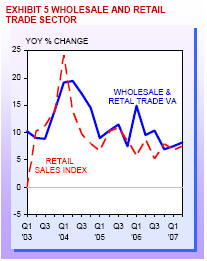
THE WHOLESALE AND RETAIL TRADE SECTOR expanded 8.2% in 2Q07 compared
with 7.5% in 1Q07. Retail sales grew by 7.5% in 2Q07, up from 6.8%
in 1Q07. While motor vehicles and food and beverage sales registered
weaker growth, better performance was seen in the furniture and
household equipment, optical goods and books, and watches and
jewellery segments. Excluding motor vehicles, retail sales rose by
11%, up from 6.9% in 1Q07. In the wholesale segment, growth of
non-oil re-exports moderated to 1.3%, down from 5.8% in 1Q07.

THE TRANSPORT AND STORAGE sector grew 5.5% in 2Q07, up from 4.3% a
quarter earlier. The sea transport segment saw faster growth on the
back of robust container throughput. However, growth of sea cargo
moderated from 10% in 1Q07 to 6.8% in 2Q07.
Growth in air transport activity was more subdued, slowing down in
2Q07. This was mainly due to a moderation in air passenger traffic
growth, from 6.9% to 5.5%. Air cargo contracted by 1.1%, a slight
improvement over the 3.0% contraction in 1Q07.
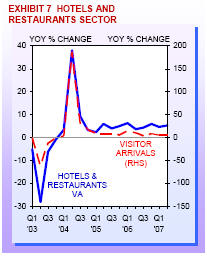
THE HOTELS AND RESTAURANTS SECTOR rose by 5.2% in 2Q07, slightly
higher than 4.8% in the previous quarter. Visitor arrivals for the
quarter grew by 4.9% compared with 5.5% in the first quarter. The
increase in hotel room revenue moderated from 22% in 1Q07 to 16% in
2Q07. The average occupancy rate of hotels remained high at 86%,
which is 2.5 percentage-points higher than the corresponding period
last year.
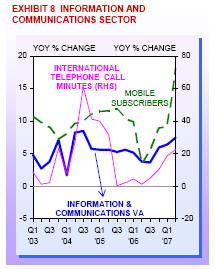
THE INFORMATION AND COMMUNICATIONS SECTOR grew 7.5% in 2Q07, up from
6.4% in the previous quarter. This was driven mainly by the
telecommunications segment while the IT segment saw some moderation
in activities. International telephone call duration grew by 22%
compared with 19% in 1Q07. The number of mobile subscribers also
expanded strongly by 18% in June, up from 9.2% in March.

THE FINANCIAL SERVICES SECTOR saw robust expansion of 17% in 2Q07,
up further from 14% in 1Q07. Broad-based growth in the sector was
led by sentiment-sensitive clusters such as the stocks, shares and
bond brokers segment. Against the backdrop of the property boom, the
domestic banking industry continued to benefit from higher loans for
building and construction activities. The offshore banking sector
was also bolstered by robust regional demand for financial services.
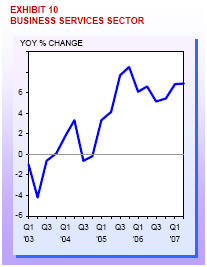
THE BUSINESS SERVICES SECTOR expanded by 6.9% in 2Q07, similar to
the 6.8% in 1Q07. The sector was well supported by healthy
performances in business representative offices and professional
services. The broadening of growth in the real estate segment also
contributed to growth of the sector.

Labour Market
Total employment continued to grow strongly by 61,900 in 2Q07,
higher than 49,400 in 1Q07. All sectors added workers, led by
services with gains of 33,600 workers. Manufacturing and
construction also posted strong increases of 16,600 and 11,400
respectively.
Reflecting the favourable economic conditions, the seasonally
adjusted unemployment rate fell to 2.4% in June 07 from 2.9% March
07. The number of workers retrenched in 2Q07 also dropped to 1,600,
from 2,000 in the previous quarter.
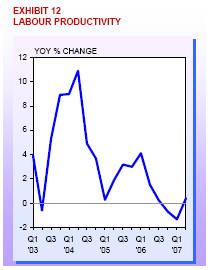
Labour Productivity
Overall labour productivity improved by 0.4% following a 1.3% drop
in the previous quarter. At the sectoral level, declines were seen
in hotels & restaurants (-5.4%), business services (-5.2%),
information & communications (-2.1%), other services (-1.4%) and
manufacturing (-1.0%). The sectors that saw positive productivity
growth were construction (6.4%), financial services (4.1%),
transport & storage (2.5%) and wholesale & retail trade (2.4%).
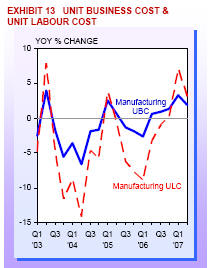
Business Costs
Overall unit labour cost (ULC) rose 5.7% in 2Q07, following a 5.9%
increase in the preceding quarter.
The unit business cost (UBC) of manufacturing rose by 1.9% in 2Q07,
following 3.3% the previous quarter. All three components rose, viz.
manufacturing ULC, services cost and government rates and fees.

External Trade
External trade expanded by 2.6% in 2Q07, slightly lower than the
2.9% gain in the previous quarter. Total exports grew 2.9% following
3.4% in the previous quarter while non-oil domestic exports (NODX)
rose by 1.5% in 2Q07, down from 2.1% in the last quarter.
The growth in NODX was due to higher non-electronics NODX growth
offsetting the drop in domestic exports of electronics. Non-oil
imports (excluding aircraft and ships) fell by 0.9%, down from a
growth of 2.0% in the preceding quarter. In volume terms, total
trade grew by 6.5% in the second quarter compared with 8.1% in the
first quarter.
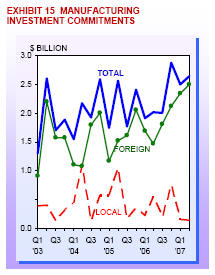
Investment Commitments
Fixed asset investment of $2.6 billion
was committed in the manufacturing sector in 2Q07, up from $2.5
billion in 1Q07. The largest investments were in the electronics
sector ($1.4 billion), followed by chemicals ($861 million) and
transport engineering ($167 million) respectively.
In terms of the local-foreign breakdown,
foreign investments amounted to 95% of the total amount while local
investments made up the rest.

Balance of Payments
Singapore¡¯s overall balance of payments surplus rose $7.6 billion in
2Q07 to reach $9.1 billion. This was due to an increase in the
current account surplus and a reduction in net outflows from the
capital and financial account. Consequently, Singapore¡¯s official
foreign reserves rose to $221 billion, equivalent to 6.9 months of
merchandise imports during the quarter.

Consumer Price Inflation
On a year-on-year basis, the CPI was 1.0% higher in 2Q07, compared
with a 0.5% gain in the last quarter. Among the major categories of
consumer expenditure, recreation costs posted the largest gain
(3.1%) due to higher holiday travel costs. This was followed by
healthcare (3.0%), food (1.4%), and transport & communications
(1.1%). Both education & stationery and clothing & footwear saw a
0.2% increase in prices. Meanwhile, housing costs declined by 1.4%,
reflecting lower electricity tariffs and housing maintenance
charges.
Outlook for 2007
The global economic environment continues to be healthy. Economic
growth in the US remains intact. The Japanese and EU economies
continue to recover on the back of strong domestic demand and firm
business sentiment. Prospects in Asia remain robust, with the
Chinese economy growing at a rapid pace. But some downside risks
remain, such as a large negative spillover from the US housing
market and potential negative supply shocks in oil. Reflecting the
favourable external environment, both manufacturing and services
firms continue to expect better business conditions in the next half
of the year. The consensus forecasts in the market for Singapore¡¯s
GDP growth are creeping upwards while the composite leading index
continues to increase.
Taking into account the above factors, the Ministry of Trade and
Industry has raised the full-year GDP growth forecast for 2007 from
5.0-7.0% to 7.0-8.0% The improved outlook reflects higher growth in
financial and business services, manufacturing, and construction.
The driving factors underpinning the higher growth forecast are
broad-based: strong global demand in the biomedical, aerospace and
marine industries, robust regional demand for financial services,
and a buoyant domestic property market.

¡¡
-------------------
1 The y-axis of the chart on business expectations
represents the net weighted balance of companies that predict an
improvement in business situation. This is derived from the weighted
percentage of companies in the survey that predict better business
minus the weighted percentage of companies that predict worse
business.
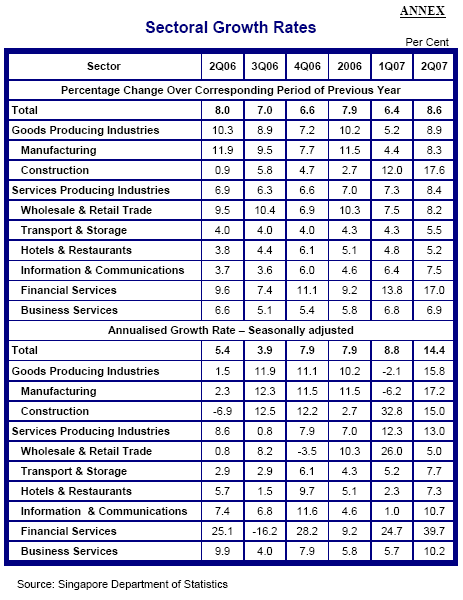
Source:
www.mti.gov.sg Press Release
10 Aug 2007

|